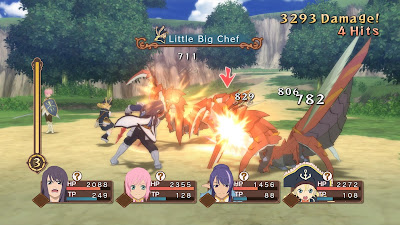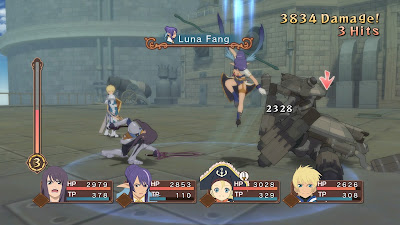Tales of Vesperia: Definitive Edition is a remaster of the game from the Xbox 360 and PS3 era. However, this uses the PS3 version that was exclusive to Japan, which had a ton of exclusive content. This is an action RPG and it is a familiar system for people who has played the Tales series. You control one character in a party of four, with the AI controlling the other three. Battles take place in a separate screen and the default has you running in a straight line to or from your target. You may also free-run around the arean by holding the trigger button.
There is a normal attack that can combo, and supplementing that is an artes button. Artes are either special moves or magic, that you can chain onto the end of a normal combo. The combat system can be similar to a fighting game in that you map different artes to a combination of the button press and a direction of the analogue stick. It’s fun and clever and once you’re able to get a feel of the system, it is also addictive. Being able to block and use items rounds out the combat system. The AI is customizable to a degree. You can set parameters and general behaviours, such as a specific character will use an item when HP is low, or another character will focus on healing. You can then set three pre-set strategies which you can change during battle.
The combat system can take some time to get used to, especially if you prefer faster combat mechanics. For some reason, your character has a long animation before and after every combo where they are vulnerable. What this means is that you are more than likely to be interrupted by enemies and it can be a frustrating experience. The worst part of the combat comes to the forefront in the battles where you are forced to fight solo against a group of enemies. It’s not a pleasant experience when you are being stunlocked to death. It rubs salt into the wound when some of these solo battles act as tutorials that you end up dying in and being forced to reload a save… and the game uses save points. There is no auto-save either so if you forgot to save for a while and die to an enemy or boss, then you will have to repeat everything again.
This is a classic JRPG so it has towns, dungeons and a world map. Its earlier 3D roots are evident given that the camera is fixed when exploring dungeons and towns. At least there are no random encounters as enemies will appear in the field. You can initiate a battle by running up again them, but sometimes it is impossible to avoid when the paths are so narrow. The graphics has aged well thanks to the anime style and the bright color palette. The game’s dungeons aren’t too big but they are designed in such a way that it often uses up a lot of your time solving “puzzles”. These puzzles boil down to pushing the right levers and then there’s the backtracking required. The only saving grace is that once you have defeated the enemies in a dungeon, they do not reappear on the map unless you exit and re-enter that screen.
The story follows Yuri, who is soon joined by a noble lady from the castle, Estelle. This is a world where there is something called blastia. The energy that blastia provides is crucial to society. Yuri ends up trying to track down a blastia core thief, while Estelle accompanies him as she wants to find a knight named Flynn, whom Yuri knows. They leave the city and end up traveling the world with other characters joining them in the process. It’s atypical JRPG story but one that isn’t bad and has a lot of good comedic moments.
Events can be a bit dark sometimes, which is a surprise considering that most of the game is bright and colorful like a typical JRPG. Yuri does a few things that are clearly not the “right” thing to do, even though his actions can be justified. This leads to the group having to work out their differences. While this may sound painful, it’s done in a way that isn’t overbearing, although there are a lot of plot threads that doesn’t get resolved in the game. The Tales series also has something called skits, which are smaller optional cutscenes using 2D portraits. These are great in that they add a lot to the character development, and are usually scenes that might not have fitted in if it was a proper cutscene.
This is a huge game. The story alone has hours and hours of cutscenes, but it also boasts a huge number of sidequests. These sidequests are usually broken into many smaller parts spread out across the game, rather than one long chain that you can do immediately. The game is infamous for a lot of these sidequests to be easily missable, so you really need to follow a guide if you wanted to see everything. There is a tendency for the game to constantly shuffle your party members. They come and go as they please when the story dictates and this can be annoying. The game compensates for this somewhat with a large cast of playable characters.
You’ll often be short of money and to get all the equipment, you will need to have drops from monsters in order to “synthesize” them. However, this is part of the addictive nature of the game as weapons and certain other types of equipment will have skills attached to them. These are passive abilities that you can permanently equip onto your character once they have used the equipment in enough battles. In this way, you can load many abilities onto your characters to improve them. The game has free DLC that you can download and use. Some of them are nice, such as addition money and costumes, while others not so as they make the game too easy. Things such as increasing your levels tends to ruin the first playthrough experience if you’re not careful.
The final dungeon can be slightly annoying and confusing as they are some environmental puzzles where you need to hit several things to open up new paths. The different screens can start to blend in with each other thanks to the similar layouts and style. The final boss was also fine but just felt somewhat anticlimactic, especially once you defeated him and you expected a long ending scene. It covers off the immediate threat but if you were expecting a full-on epilogue or something long to see how the characters were afterwards (since there were pretty drastic consequences from the final battle), then you’ll be disappointed.
The game takes around 40 to 50 hours to get to the end so this is by no means a short game. All the optional scenes and activities can give you additional hours of content but a lot of them requires rampant backtracking. The postgame content consists of reused dungeons to defeat enemies with swapped color palettes, with some new bosses spread throughout. There is a New Game Plus where you can spend the “grade” you earned during the game (which roughly correlates with how well you’ve played the game) for additional bonuses and things to carry over.
Overall, Tales of Vesperia: Definitive Edition is a great game and a classic JRPG through and through with all the genre’s good and bad. The bright colorful anime aesthetics means that it has aged remarkably well while the fast paced combat system is a lot of fun. The combat mechanics are deeper than at first glance and while it is a bit rough to start with, evolves into a finetuned system. The same goes with the story which starts off a bit slow but eventually the characters are developed enough that you’d love each of their individual quirks.
---------------------------------------------------
(As an Amazon Associate I earn from qualifying purchases)











